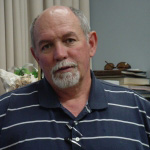 Professor Emeritus
Professor Emeritus
Research Areas
DNA structure, enzymology, and gene regulation
Biography
Patrick Higgins (b. 1946) completed undergraduate studies at Wichita State University. He obtained a Ph.D. degree in the Department of Microbiology from the University of Chicago (1976) working with Dr. Bernard Straussin the Department of Microbiology, and he extended work at the U of C in the Department of Biochemistry as a postdoc in Nicholas Cozzarelli’s lab where he was first to purify the subunits of DNA gyrase. In 1979 he was appointed to the faculty of the University of Wyoming and he moved to Birmingham in 1984. He currently holds the rank of Professor Emeritus of Biochemistry and Molecular Genetics at the University of Alabama at Birmingham.
Research Interests
Biological development in all organisms involves programmed changes in gene expression. During evolution, genes have transposed from place to place and they became integrated into temporally and developmentally regulated biochemical pathways. The principal focus of my laboratory is characterizing genetic changes lead to differentiation of two species from a common ancestor. I focus on two bacterial species - E. coli and Salmonella Typhimurium.
RNA transcription, protein translation, and DNA repair are made up of multiple complex enzymes that must be tuned with each other to promote efficient growth and cell division. For example, the average catalytic rate of transcription at 30° in both E. coli and Salmonella Typhimurium is 50 RNA nucleotides/sec. To sustain protein syntheses at this rate, DNA gyrase must introduce 5 supercoils/sec downstream of transcription and TopA protein must remove the same number of supercoils upstream to maintain chromosome structure(1). In addition, replisomes must coordinate with RNA polymerases on highly transcribed regions to manage protein traffic on many segments of DNA. In bacteria RNA synthesis is immediately followed by association with ribosomes that translate the message at average speed of 17 amino acid/sec. The new proteins must fold properly, so chaperones like DnaK fold at the speed of synthesis to keep cells fit. When cells are moved from an environment at 30° to 40°, all of these processes increase by a factor of 2 due to the Q10 rule of quantum chemistry.
To understand how enzyme rates and multiple proteins are integrated for maximal cell efficiency, I am exploiting an ultra-high affinity tag and capture system developed in the Dmitry Vassylyev lab to dissect cellular multi-protein systems. With this method I can tease out critical proteins that are connected to a target cellular pathway in a single day(2). I find that the DnaK chaperone is associates with the 60 most highly transcribed proteins along with RNA polymerase, ribosomes, and the transducing proteins that insert proteins into the membrane and transport proteins across the cell membrane to the periplasm. With a tag on GyrA, the DNA-binding subunit of gyrase, one can identify the high affinity gyrase binding sites across an entire chromosome(3). When the tag is on the DNA binding subunit of Topo IV, you see stable connections to bacterial condensin MukB as well as to proteins involved ATP synthesis from ADP. What one learns using this methods is how the associated proteins of different biochemical pathways generate unique pieces that fit together in the complex and dynamic jig saw puzzle of molecular biology and biochemistry.
{slide=Selected Publications}Rovinskiy, Agbleke, A. Chesnokova, O. N., Pang, Z., and Higgins, N.P., 2012. "Rates of gyrase supercoiling and transcription elongation control supercoil density in a bacterial chromosome." (2012) PLoS Genet 8 (8): e1002845.
Vassylyeva, M.O. , Klyuyev, S.,Vassyslyev, A.D., Wesson, H., Zhang, Z. Renfrow, M.B., Wang, H., Higgins, N.P., Chow, L.T., Vassylyev, D.G. "Efficient, ultra-high-affinity chromatography in a one-step purification of complex proteins.” (2017) Proc Natl Acad Sci USA 114, (26) E5138-E.
Higgins, N. P. "Species-specific supercoil dynamics of the bacterial nucleoid." (2016) Biophys Rev 8 (Suppl 1): 113-121.
Higgins, N. P. (2012). Gyrase. The Encyclopedia of Genetics. New York, Elsevier Science Publishing Co., Inc.: 2012. PMID 21143310.
Higgins, N. P. (2005). The Bacterial Chromosome. Washington, D.C., ASM Press.
Higgins, N. P. (2001). Chromosome Structure. Encyclopedia of Life Sciences. J. Howlett. London, Elshiver.
Higgins, N. P. (1999). DNA supercoiling and its consequences for chromosome structure and function. Organization of the Prokaryotic Genome. R. L. Charlebois. Washington, D.C., ASM. 1: 189-202.
Higgins, N. P. (1998). "Mobile Genetic Elements: a review." Quarterly Reviews in Biology 73: 68-69.
Higgins, N. P., A. Ferro and B. M. Olivera (1990). DNA topoisomerase modification. DNA topology and its biological effects. N. R. Cozzarelli and J. C. Wang. Cold Spring Harbor, Cold Spring Harbor Laboratory: 361-370.
Zhu, J. L., D. Hillyard and N. P. Higgins (1989). "Nucleotide sequence of the Salmonella typhimurium himA gene." Nucleic Acids Res 17(21): 8880.
Higgins, N. P. and N. R. Cozzarelli (1989). DNA-joining enzymes: A review. Methods Enzymo. New York, Academic Press, Inc. 68: 50-79.
Higgins, N. P. and B. S. Strauss (1979). "Human lymphoblastoid lines differ in their ability to exclude bromodeoxyuridine and in their sensitivity to methylmethanesulfonate and to incorporated 3H-thymidine." Cancer Res. 39: 312-320. PMID 216485.
Strauss, B., K. Tatsumi, P. Karran, N. P. Higgins, E. Ben-Asher, M. Altamarino-Dimas, L. Rosenblatt and K. Bose (1978). "Mechanism of DNA excision repair in human cells." Polycyclic Hydrocarbons and Cancer 1: 177-201.
{/slide}Education
Graduate School
Ph.D., University of Chicago
Postdoctoral Fellowship
University of California
Contact
Office
McCallum Basic Sciences Building
Room 572
1918 University Boulevard
Birmingham, AL 35294-0005
Phone
(205) 934-3299
Email
nphiggin@uab.edu